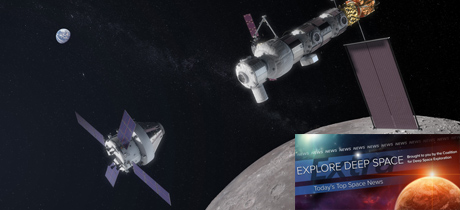In Today’s Deep Space Extra… NASA’s Safety Advisory Panel (ASAP) wants the agency to apply lessons learned with Commercial Crew Program to development of a lunar lander. Meanwhile, some in Congress are expressing concern NASA’s efforts to accelerate a return to the Moon with human explorers to 2024 could jeopardize funding for the agency’s science missions. NASA’s strategy to encourage a greater low Earth orbit role for the U.S. private sector has the space community talking.
Human Deep Exploration
Safety panel calls on NASA to apply commercial crew lessons for Artemis
Coalition Member in the News – Boeing
SpaceNews.com (6/11): NASA’s Safety Advisory Panel has advised the agency to assess and include lessons learned from its Commercial Crew Program led development of the Boeing CST-100 Starliner and SpaceX Crew Dragon in overseeing the commercial lunar lander element for Artemis, the recently announced accelerated effort by NASA to return to the surface of the Moon with astronauts in 2024, four years earlier than previous plans. “The sense of schedule urgency can be positive and effective, but should not be a pressure that engenders decisions or actions that undermine mission assurance and safety,” said Patricia Sanders, chair of the panel.
NASA administrator says ‘nothing has changed’ after Trump’s tweet about the Moon and Mars
The Verge (6/11): NASA Administrator Jim Bridenstine offered fresh assurances that the agency is going back to the Moon with human explorers and then to Mars during a town hall gathering of employees and area leaders at the Glenn Research Center in Ohio on Monday afternoon. The remarks followed social media comments from President Trump last Friday in which he suggested NASA was not speaking out enough about the horizon goal of Mars.
Companies express varying interest in NASA’s ISS commercialization plan
SpaceNews.com (6/11): On Friday, NASA presented a strategy to encourage a future expansion of the low Earth orbit commercial market. The plan would open the International Space Station (ISS) to limited activities by private sector astronauts and seek to transition NASA from its overseer role of low Earth orbit activities to one of many customers of future private sector operators. The response, so far, has been varied.
Bigelow aims to sell rides to Space Station on SpaceX Dragon ships for $52M a seat
GeekWire.com (6/11): Just days after NASA unveiled plans to expand the low Earth orbit commercial economy by allowing limited private sector access to the International Space Station (ISS), Bigelow Space Operations has disclosed plans to transport passengers to the station using the SpaceX Falcon rocket and Crew Dragon capsule that is currently under development to carry astronauts to and from the ISS. So far, Bigelow plans four launches with stay times of up to one to two months.
Space Science
Chairwoman Johnson worries NASA may starve science to pay for Artemis
Spacepolicyonline.com (6/11): U.S. Rep. Eddie Bernice Johnson, chair of the U.S. House Science, Space and Technology Committee, expressed concerns during a hearing Tuesday that NASA might look to its space science missions for the funds for a recent initiative to accelerate a human return to the surface of the Moon from 2028 to 2024. NASA has not provided lawmakers with a cost estimate for the acceleration. The White House 2020 budget request for NASA seeks authority for the NASA administrator to transfer funds among accounts, if necessary, to achieve the 2024 goal specified by the White House on March 26.
Decadal Surveys front and center at House hearing
Spacepolicyonline.com (6/11): The Decadal Surveys produced by the National Academies of Sciences, Engineering, and Medicine were front and center at a House hearing today on NASA’s science programs. Decadal Surveys are highly respected by NASA and Congress because they represent a consensus of the scientists engaged in each of NASA’s space and earth science disciplines on the top scientific questions that need to be answered and the missions to find those answers.
NASA moves to final planning stages for mission to explore 16 Psyche’s full metal asteroid
Tech Crunch (6/11): NASA’s Psyche mission, which is moving through the development phases, is to launch in 2022 for the asteroid 16 Psyche. The object is believed to be made of nickel and iron and potentially the valuable core of a former planet that was shattered by collisions with other planetary objects.
The search for habitable alien worlds in Earth’s backyard heats up
Space.com (6/11): The European Southern Observatory’s Very Large Telescope in Chile has been equipped with a thermal coronagraph, an instrument intended to dim the bright light of Alpha Centauri, a three star system, possibly exposing the existence of dim planets for further study. In 2016, astronomers discovered an Earth-sized planet circling on of the stars, Proxima Centauri, in the habitable zone.
Stephen Hawking was right: Black Holes can evaporate, weird new study shows
Space.com (6/11): Working in a laboratory, Israeli physicists have gathered observations supporting a theory from the late Stephen Hawking that black holes eventually evaporate despite their tremendous gravity.
Other News
Rocket firm Relativity Space signs lease with NASA for new robotic 3-D printing factory
Reuters via New York Times (6/11): Relativity Space has announced plans to lease space from NASA’s Stennis Space Center in Mississippi, where large 3-D printers will produce rockets to launch small satellites. Ultimately, the Los Angeles based company intends to print rockets on Mars.

